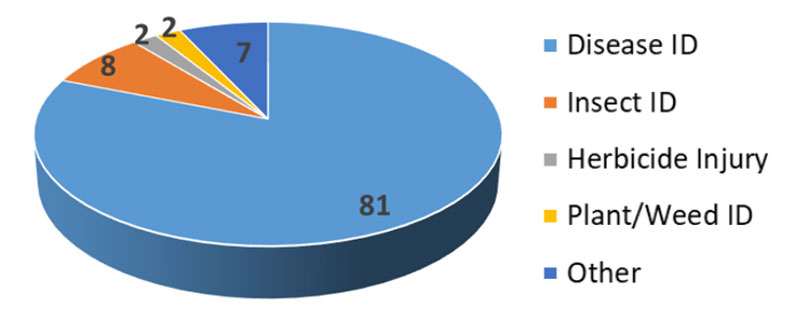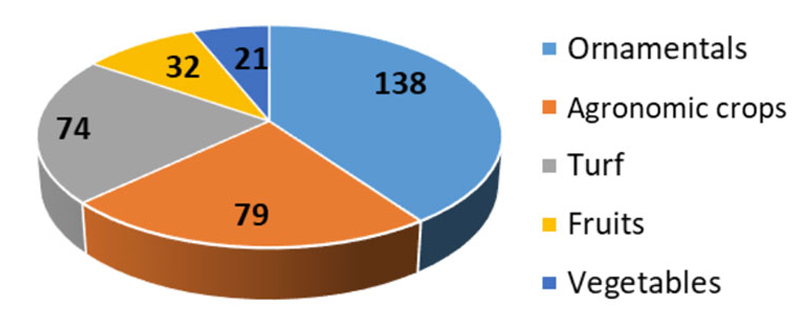Taking an environmentally sensitive approach to pest management
Plant Diagnostic Clinic 2018 annual report for horticultural crops
Published: February 28, 2019
Sample diagnosis
In 2018, the MU PDC received a total of 426 samples which includes physical samples, walk-in samples (samples not charged) and digital images submitted by email for plant disease diagnosis, insect, weed and plant identification. Disease diagnosis accounted for 81% of the total sample processed and the month of June marked the peak of submission with 95 samples (Figure 1). Samples submitted to the clinic were categorized into different crop types such as field crops, turf, ornamentals, vegetables and fruits. Ornamentals were the largest sample category with 138, followed by field crops (79) and turf (74) (Figure 2).

Figure 1 Percentage distribution of samples submitted to the clinic by type of diagnosis

Figure 2 Distribution of samples submitted for disease diagnosis by sample category
Diseases diagnosed on Ornamentals
Winter injury, chemical injury and heat stress were the major issues diagnosed on ornamental plants in 2018. The extreme heat condition in Missouri in the past year left many trees with leaf scorching, a symptom similar with to bacterial leaf scorch, a disease caused by the bacteria Xylella fastidiosa. Despite the excessive drought, some disease issues such as anthracnose, the aforementioned bacterial leaf scorch, powdery mildew, canker and dieback were observed.
Table 1 A list of diseases and pests diagnosed on different ornamental plants in 2018
Common Name |
Diagnosis |
Pathogen |
| Arborvitae | Environmental stress | Abiotic disorder |
| Ash | Hole in bark | Unidentified wood boring insect |
| Azalea | Dieback | Unknown cause |
| Leaf spot | Unidentified fungus | |
| Black Mondo grass | Anthracnose | Colletotrichum cereale |
| Boxwood | Boxwood volutella blight | Volutella buxi |
| Environmental stress | Abiotic disorder | |
| Winter injury | Abiotic disorder | |
| Bradford Pear | Leaf spot | Unknown cause |
| Carex Flacca | Anthracnose | Colletotrichum spp. |
| Rhizoctonia root rot | Rhizoctonia spp. | |
| Chicory | No pathogen found | Identification analysis |
| China Aster | Unknown | Unidentified fungus |
| Choke Cherry | Lace bug | Corythucha spp. |
| Juniper | Environmental stress | Abiotic disorder |
| Twig blight | Botryosphaeria spp. | |
| Crabapple | Frogeye leaf spot | Botryosphaeria obtusa |
| Dahlia | Unknown | Unidentified agent |
| Daylily | Bacterial soft rot | Pectobacterium spp. |
| Dogwood | No pathogen found | Identification analysis |
| Dragon Wing Begonia | Heat stress | Abiotic disorder |
| Dusty Miller | Verticillium wilt | Verticillium spp. |
| Eastern White pine | Abiotic disorder | Abiotic disorder |
| White pine decline | Abiotic Factors | |
| Winter injury | Abiotic disorder | |
| Eunonymus Shrub | Twig blight | Botryosphaeria spp. |
| Environmental stress | Abiotic disorder | |
| European Beech | No pathogen found | Identification analysis |
| European Hornbeam | Cytospora canker | Cytospora spp. |
| Canker | Nectria spp. | |
| Insufficient sample | Identification analysis | |
| Forsythia | Dieback | Unknown cause |
| Fragrant Sumac | Anthracnose | Colletotrichum spp. |
| Fringe Tree | No pathogen found | Identification analysis |
| Hawthorn | Cedar-quince rust | Gymnosporangium clavipes |
| Hosta | No pathogen found | Identification analysis |
| Hydrangea | Pythium root rot | Pythium spp. |
| Holly | Twig blight | Botryosphaeria spp. |
| No pathogen found | Identification analysis | |
| Abnormal root development | Unidentified agent | |
| Maple | Anthracnose | Kabatiella spp. |
| Insect damage | Unidentified Insect | |
| Environmental stress | Abiotic disorder | |
| Tar spot | Rhytisma spp. | |
| Japanese lilac | Spider mites | Tetranychidae |
| Japanese yew | Heat stress | Abiotic disorder |
| Winter injury | Abiotic disorder | |
| Environmental stress | Abiotic disorder | |
| Lavender | Anthracnose stem blight | Colletotrichum spp. |
| Lily-of-the-valley | Leaf spot | Unknown cause |
| Magnolia | Chemical injury | Abiotic disorder |
| Winter injury | Abiotic disorder | |
| Sooty mold | Capnodium spp. | |
| Spruce | Abiotic disorder | Abiotic disorder |
| Phomopsis twig blight | Diaporthe occulta | |
| Abnormal plant growth | Abiotic disorder | |
| Winter injury | Abiotic disorder | |
| Orchard grass | Anthracnose | Colletotrichum spp. |
| Oak Tree | Insect damage | Unidentified wood boring insect |
| Bacterial leaf scorch | Xylella fastidiosa | |
| Herbicide injury | Abiotic disorder | |
| Leaf spot | Tubakia spp. | |
| Oak decline | Abiotic Factors | |
| Powdery mildew | Erysiphe spp. | |
| Drought stress | Abiotic disorder | |
| Anthracnose | Apiognomonia spp. | |
| Canker | Hypoxylon spp. | |
| Oak leaf Phylloxeran | Phylloxera glabra | |
| Oak lace bug | Corythucha arcuata | |
| Oak twig canker and dieback | Botryosphaeria quercuum | |
| Privet | Chemical injury | Abiotic disorder |
| Insect damage | Unidentified insect | |
| Purple leaf Plum | No pathogen found | Identification analysis |
| Snapdragon | Verticillium wilt | Verticillium spp. |
| Sedum | Bacterial blight | Unidentified bacteria |
| Swedish Ivy | Bacterial blight | Xanthomonas spp. |
Turfgrass disease diagnosis
Of the 74 turfgrass samples submitted for analysis, 37 were out-of-state from Iowa, Kansas, Kentucky and Illinois. Turfgrass species submitted for diagnosis include creeping bentgrass, fescue, zoysia and Kentucky bluegrass. Most samples were from creeping bentgrass putting greens, which like other cool season species endured a difficult spring with the 2nd coldest April on record followed by the warmest May – June on record. This weather anomaly, and resultant lack of spring, didn't allow for adequate root development prior to the summer stress period. On tall fescue lawns, several instances of gray leaf spot were observed in the St Louis and Columbia area. Gray leaf spot occurs late season (August – September), and has not been typical in recent years. The disease can be problematic since it can spread very quickly by spores, fungicide resistant populations are known, and management practices differ from brown patch, a more regular disease issue on tall fescue.
Table 2 A list of diseases and abiotic issues diagnosed on turfgrass in 2018
Type of turfgrass |
Diagnosis |
Pathogen/abiotic issue |
| Bentgrass | Environmental stress | Abiotic |
| Algae | Algae | |
| Anthracnose basal rot | Colletotrichum spp. | |
| Basal leaf anthracnose | Colletotrichum spp. | |
| Black layer | Abiotic | |
| Lance nematode | Hoplolaimus spp. | |
| Pythium root rot | Pythium spp. | |
| Take-all | Gaeumannomyces spp. | |
| Winter desiccation | Abiotic | |
| Bacterial etiolation | Bacteria | |
| Fescue | Anthracnose | Colletotrichum spp. |
| Brown patch | Rhizoctonia spp. | |
| Gray leaf spot | Pyricularia grisea | |
| Melting out | Drechslera spp. | |
| Root-knot nematode | Meloidogyne graminis | |
| Zoysia | Winter injury | Abiotic |
| Chinch bug | Blissus spp. | |
| Large patch | Rhizoctonia solani AG2-2 LP | |
| Creeping bentgrass | Black layer | Abiotic |
| Fairy ring | Various fungi | |
| Pythium root rot | Pythium spp. | |
| Wet wilt | Abiotic |
Diseases diagnosed on fruits and vegetables
Fruits and vegetables submitted to the clinic were diagnosed with several issues like abiotic stress, chemical injury and diseases. Chemical injury reported on okra, tomato and potato in some cases occurred from herbicide used in close proximity or herbicide carryover in manure/compost. Foliar and fruit rot diseases were diagnosed on pumpkin, cucumber, cabbage, pepper and tomato. Root rot disease caused by Fusarium and Phytophthora species were reported on tomato, watermelon, blueberry and raspberry samples.
Table 3 A list of diseases and abiotic issues diagnosed on fruits and vegetables in 2018
Plant |
Diagnosis |
Pathogen/Pests |
| Watermelon | Crown, root and stem rot | Phytophthora spp. |
| Two-spotted spider mite | Tetranychus urticae | |
| Tomato | Herbicide injury | Abiotic disorder |
| Abnormal plant growth | Abiotic disorder | |
| Bacterial leaf spot | Xanthomonas spp. | |
| Crown and root rot | Phytophthora spp. | |
| Early blight | Alternaria solani | |
| Fusarium wilt | Fusarium oxysporum f.sp. lycopersici | |
| Septoria leaf spot | Septoria lycopersici | |
| Pumpkin | Fusarium fruit rot | Fusarium spp. |
| Squash bug | Anasa tristis | |
| Potato | Herbicide injury | Abiotic disorder |
| Pepper | Alternaria fruit rot | Alternaria spp. |
| Bacterial soft rot | Pectobacterium spp. | |
| Cucumber | Anthracnose | Colletotrichum orbiculare |
| Cabbage | Bacterial soft rot | Pectobacterium spp. |
| Cantaloupe | Cercospora leaf spot | Cercospora spp. |
| Okra | Chemical injury | Abiotic disorder |
| Blackberry | Dieback | Unidentified fungus |
| Blueberry | Bacterial leaf scorch | Xylella fastidiosa |
| Botrytis blight | Botrytis spp. | |
| Crown and root rot | Phytophthora spp. | |
| Dieback | Unknown | |
| Stem canker | Botryosphaeria spp. | |
| Elderberry | Leaf blight | Alternaria spp. |
| Grape | Fruit spot | Unidentified agent |
| Peach | Mold | Penicillium spp. |
| Pear | Canker | Unidentified agent |
| Fire blight | Erwinia amylovora | |
| Raspberry | Root rot | Phytophthora spp. |
| Sphaerulina leaf spot | Sphaerulina spp. | |
| Apple | Alternaria fruit rot and spot | Alternaria spp. |
| Apple black rot | Diplodia seriata | |
| Fruit rot | Unidentified agent | |
| Bitter pit | Abiotic disorder | |
| Senescent breakdown | Abiotic disorder | |
| Lenticel breakdown | Abiotic Disorder |
The PDC is open year round for sample submission. A general diagnosis is $15, additional services are $10 each if special testing such as an ELISA/immunostrip, culture plating or molecular diagnosis is required. Please visit our PDC website http:// plantclinic.missouri.edu/ or call (573-882-3019) for more information.
Subscribe to receive similar articles sent directly to your inbox!
REVISED: February 21, 2017